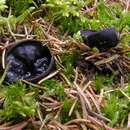pt-BR
nomes no trilho de navegação


Pseudoplectania is a genus of fungi in the family Sarcosomataceae. The genus contains 12 species. Pseudoplectania ryvardenii was described in 2012, while Pseudoplectania carranzae was transferred to the genus (from Plectania) in 2013.
The genus was circumscribed by the German botanist Fuckel in 1870, who originally included the two species P. nigrella and P. fulgens.[2] The latter species was removed from the genus by Pier Andrea Saccardo in 1889, and made the type species of his newly created genus Otidella (now considered synonymous with Caloscypha as described by Boudier in 1885;[3] P. fulgens is now Caloscypha fulgens). Saccardo added the species P. melania and P. stygia, the latter of which is thought to be synonymous with P. nigrella.[4]
Phylogenetic analysis based on the DNA sequences of ribosomal RNA suggests that Pseudoplectania groups in a clade together with Galiella, Plectania, Urnula, Sarcosoma, and Donadinia, and that it is most closely related to the latter genus. Pseudoplectania differs from Plectania mainly in spore shape—spherical in Pseudoplectania compared to ellipsoidal in Plectania.[5]
The generic name means false plectania.
The fruit bodies of Plectania fungi grow either in groups or scattered apart, with stems or without (sessile), and are large and fleshy. They are covered on the external surfaces with short, slender, flexuous (bendy) and often coiled or twisted hairs that sometimes give the exterior of the cup a tomentose appearance—covered with dense, matted hairs. The spore-bearing cells, the asci, range in shape from cylindrical to club-shaped, and they are eight-spored. The spores are perfectly spherical, smooth, and hyaline (translucent). The paraphyses may be either straight or curved.[4]
Twelve species are accepted in the genus:[6]
Pseudoplectania is a genus of fungi in the family Sarcosomataceae. The genus contains 12 species. Pseudoplectania ryvardenii was described in 2012, while Pseudoplectania carranzae was transferred to the genus (from Plectania) in 2013.
Pseudoplectania Fuckel (czareczka) – rodzaj grzybów należący do rodziny Sarcosomataceae[1].
Pozycja w klasyfikacji według Index Fungorum: Sarcosomataceae, Pezizales, Pezizomycetidae, Pezizomycetes, Pezizomycotina, Ascomycota, Fungi[1].
Synonim nazwy naukowej: Melascypha Boud.[2].
Nazwy polskie według M.A. Chmiel[3].
Wykaz gatunków (nazwy naukowe) na podstawie Index Fungorum[5]. Nazwy polskie według M.A. Chmiel[3]..
Pseudoplectania Fuckel (czareczka) – rodzaj grzybów należący do rodziny Sarcosomataceae.